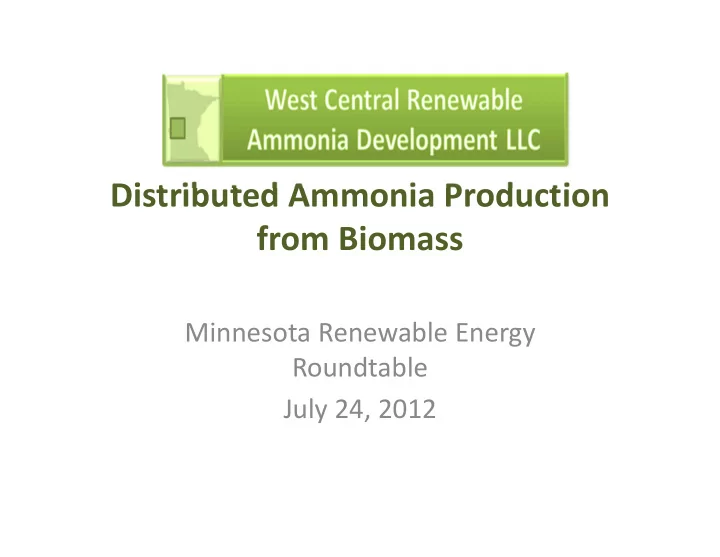

Distributed Ammonia Production from Biomass Minnesota Renewable Energy Roundtable July 24, 2012
West Central Renewable Ammonia Development LLC • Public/private collaboration to develop biomass to anhydrous ammonia project in west central Minnesota • Project milestones and objectives: – Develop biomass supply of 100,000 tons per year – Engineer unified conversion process using commercially available technologies – Estimate capital & operating costs of proposed plant – Prepare financing plan for construction & operations
Project History • 2009 ‐ Ag sub ‐ committee of the Kandiyohi County/Willmar Economic Development Commission identified ammonia opportunity • 2010 preliminary feasibility study conducted – Wind to ammonia not economic – Biomass to ammonia has potential • 2011 Next Gen grant opened and WCRAD was formed to pool public/private resources • 2012 WCRAD awarded grant
Acknowledgements • The effort for local ammonia production has benefited from the efforts of a number of people among them: – West Central Research & Outreach Center • Mike Reese – S.L. Simon Engineering PA • Stan Simon – Swift County EDC • Jennifer Gruis – Kandiyohi County/Willmar EDC • Steve Renquist and Cathy Keuseman
Strategic Issue • Achieving Minnesota’s goal of 25 x 25 depends heavily on crop and crop residue for biomass supply. • Crop productivity depends on a reliable source of nitrogen fertilizer • Dependency transfers from foreign oil to foreign ammonia
Economic Significance • All nitrogen fertilizers used in Minnesota are produced out of state and most are out of country. • Fertilizer producers have changed their pricing strategy to “value added” basis as opposed to “cost to produce” based • The result is a significant burden on MN agriculture – about $500 million for corn alone
The Price of Ammonia is Tied to Corn
Farmgate Prices at Record Highs
Sources & Uses of Funds Debt Financing $29,000,000 Seed Equity 1,500,000 Member Equity 27,500,000 Total Sources of Funds $58,000,000 Buildings & Equipment $52,000,000 Soft Costs 2,800,000 Pre ‐ Production Expenses 1,000,000 Working Capital 2,200,000 Total Uses of Funds $58,000,000
Breakeven Prices EBITDA Analysis Net Income Analysis Biomass NH 3 Biomass NH 3 $/Ton $/Ton $/Ton $/Ton $ 0.00 $252.45 $ 0.00 $109.82 $ 25.00 $299.20 $ 25.00 $163.57 $ 50.00 $352.95 $ 50.00 $217.32 $ 75.00 $406.70 $ 75.00 $271.07 $100.00 $460.45 $100.00 $324.82
Project Questions • Establish biomass supply chain – Is pelleting a cost savings? – What role for natural gas? • Process design – Is the gasification technology ready? – Can we produce 99.999% hydrogen? – What ammonia reactor design will we use? • What form of nitrogen fertilizer will we produce?
Biomass Supply Biomass Source Annual Acres Available biomass tons per year CRP lands – 1/3 per year 1/3 of 185,299 123,486 Spoiled hay – 3% of acres 3% of 139,500 15,000 Wheat straw 73,100 73,100 Corn for Grain 1,086,300 2,172,600 Corn to Sugar Beets 94,800 189,600 Sweet Corn Stover 100,000 200,000 7 County totals 2,773,786 We need 95,000 tons per year 3% of the available
Biomass Supply Second Phase • Sort the biomass supply by harvest window • Maximize utilization of the harvest equipment • Widen the harvest window to protect against weather • Corn stover is not expected to be the largest contributor • Identify specific farmers and land for contracting • Moving from aggregate to specific for biomass sources
Wood Chips or Pellets Sources of Woody Biomass: Logging residue • “Primary” mill residue • “Secondary” mill residue • Dedicated energy crops • Land clearing projects • Brush from brush lands • Assumption: 30,000 tons or 4% of available tons Pre ‐ commercial thinning • Minnesota’s Forest Biomass Value Chain The project’s prime back ‐ up Page 24… ….“There are 800,000 green tons available & the next four years”…. 6 ‐ month reserve supply Source: BioBusiness Alliance of Minnesota
Natural Gas • Natural gas prices are low ‐ $4 per million Btu or less • Up to 1/3 of biomass can be replaced with natural gas with no process change. • What role should natural gas play in the process design? – As start up fuel? – As operating fuel? – As feedstock?
Biomass to Ammonia Process
Process Issues • Gasification – Feedstock flexibility – Yield – Syn gas quality • Hydrogen production – Water gas shift performance – Hydrogen separation • Ammonia Reactor – Conventional Haber Bosch – Urea reactor
Nitrogen Forms • Nitrogen fertilizer can be applied in several forms – Anhydrous ammonia – Urea – Aqueous Ammonia – UAN solution • It is dangerous to assume you can change customer preference but the cost effects are substantial
In Summary • There is strong incentive for Minnesota to become its own nitrogen fertilizer supplier. • The current pricing strategy is creating a price umbrella which invites competition. • At issue: – Is the technology available to execute the process? – Will the business withstand predatory response?
Recommend
More recommend